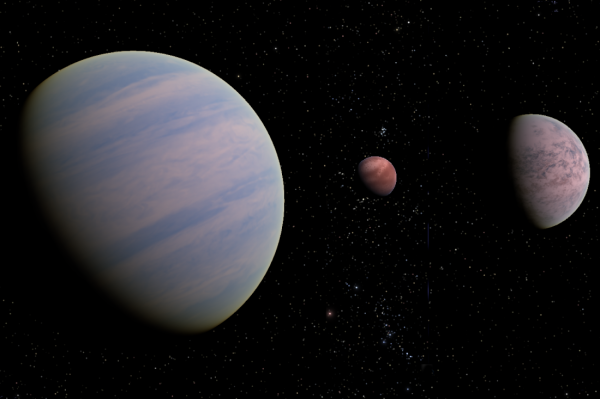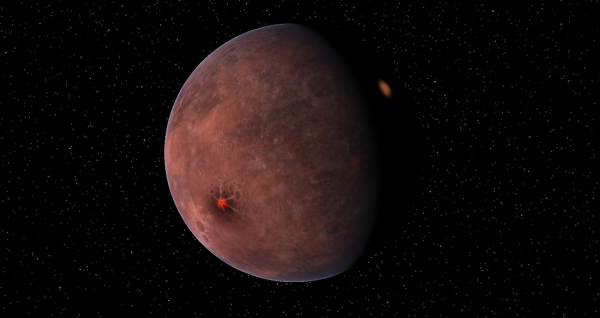BY LETTER
Eunchong (Gliese 832)
Galactography > Regions of Space > Inner Sphere
Galactography > Systems and Worlds > Systems & Worlds E - F
Galactography > Systems and Worlds > Systems & Worlds E - F
Red dwarf near Sol; former member of the Eridanus League | |
 Image from Steve Bowers | |
| The planets of the Eunchong system; Salvador, Bunsu and Palida | |
Eunchong System - Data Panel | |
| System | Names: Eunchong Location: - Distance from Gatlida: 4.838 ly (J2000) - Distance from Sol: 16.19 ly (J2000) - Constellation: Grus Reached: 798, by colonists abroad the Trinity. |
|---|---|
| Star | Names: Eunchong, Gliese 832 (GJ 832), HD 204961, HIP 106440, Kang 21 Physical characteristics: - Mass: 0.45 x Sol - Radius: 0.48 x Sol - Luminosity: 0.036 x Sol (bolometric) - Temperature: 3,620 Kelvin - Spectral type: M2V - Rotation period: 45.7 days - Age: 9.24 billion years System: 1) Palida: Videntian TholiNeptunian CereJotunnian AquaMuspellian Semi-major axis = 0.162 AU, Orbital period = 35.68 days, Eccentricity = 0.18, Mass = 6.235 x Earth, Radius = 2.671 x Earth 2) Bunsu: Videntian LapiMinervan Achlysian IgneoGanymedean Semi-major axis = 0.212 AU, Orbital period = 53.52 days, Eccentricity = 0.175, Mass = 0.119 x Earth, Radius = 0.529 x Earth 3) Salvador: MethoJovian HydrogeoBarian Semi-major axis = 3.56 AU, Orbital period = 10.01 days, Eccentricity = 0.08, Mass = 249.6 x Earth, Radius = 10.54 x Earth |
| Information | Population: 728 billion Overseer: none Allegiance: Chiefly Zoefic, Negentropic, and Terragen Federation, with minor Utopian and Solarist elements. Deeper Covenant presence at the edge of the system. Government: Approximately 770 independent polities. Transportation: Well developed Lightways and Beamrider Network infrastructure, no wormhole access. |
However, the colonists, having designed their mission to revolve around space inhabitation, lacked the expertise to design and operate vehicles in planetary environments. The Bunsu mining project was hence plagued with failures; the first few vessels disintegrated in Bunsu's atmosphere or impacted the planetary surface, and several more suffered catastrophic failures shortly after touchdown. Concerns over the dwindling resources grew along with the failure count, and increasingly, the colonists questioned their leadership and the project. Under heavy pressure, the colonial government was forced to adopt a less radical take on their doctrines, and the president, Mauro Young, was forced to resign. The newly reformed government was not against responding to the River of Stars Charter. Their request for an ambassador-judge and technical help was answered by Ran, otherwise known as Epsilon Eridani.
 Image from Steve Bowers | |
| Bunsu, a volcanically active Hephaestian world | |
Although Eunchong technically remained independent at first, their culture and ideology became so heavily diluted by the Eridan culture (especially the Epsilon Indi cultures) over the next few hundred years that by 1100, little traces of the original culture remained. The system was officially integrated into the Eridanus League in 1128.
When the League eventually dissolved, a large number of the polities in this system became associate members of the Zoeific Biopolity, although others joined the Negentropy Alliance, the Mutual Progress Association, and the Terragen Federation.
Related Articles
Appears in Topics
Development Notes
Text by The Astronomer (2016)
From an original article by Aaron Hamilton
Initially published on 31 July 2000.
Overhauled 2020-05-08; text by The Astronomer
From an original article by Aaron Hamilton
Initially published on 31 July 2000.
Overhauled 2020-05-08; text by The Astronomer
Additional Information
-Author's Note-
Salvador and Palida represent the real world exoplanets Gliese 832 b and Gliese 832 c, respectively. Bunsu is a fictional planet.
Kang 21, originally Kang 021, is believed to be a fictional star catalog that was what the system was referred to in the past. It is kept after the update.
Salvador and Palida represent the real world exoplanets Gliese 832 b and Gliese 832 c, respectively. Bunsu is a fictional planet.
Kang 21, originally Kang 021, is believed to be a fictional star catalog that was what the system was referred to in the past. It is kept after the update.






